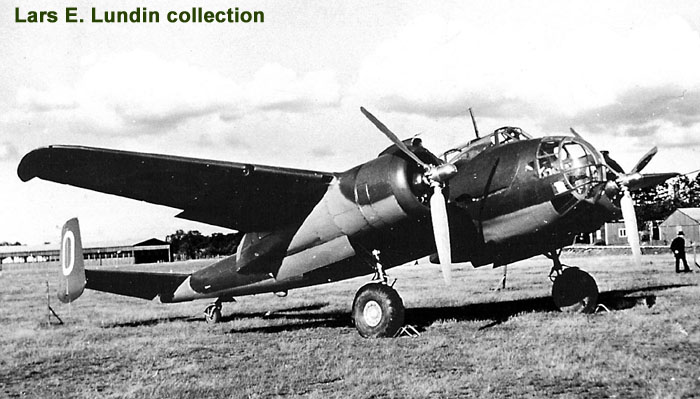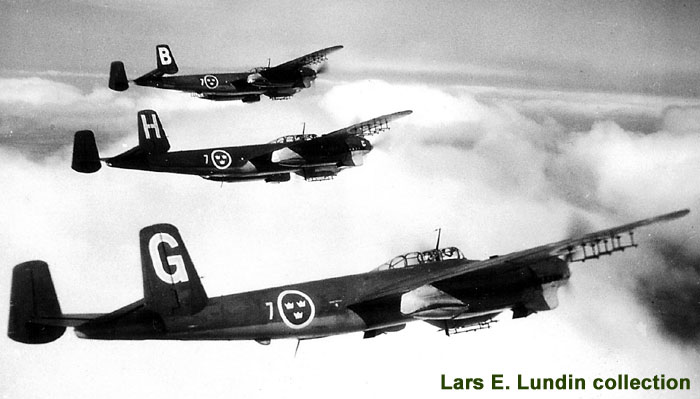|
|
||
| B 18 - SAAB 18 (1944-1959) | ||
|
|
Page 1 (of 2) |
|
|
|
||
 |
||
 |
||
|
The
crew department was asymmetrically placed to the left of the centreline of
the rather narrow fuselage.
The crew of three had to share a rather small ”office”, where
the navigator’s seat was directed backwards.
The
B 18 was built in two versions - B 18A and B 18B. B 18A
was fitted with two Swedish-built ”pirate copies” of
the Pratt & Whitney Twin Wasp STW C-3 engine, each delivering
1.065 hp. The aircraft could carry a bomb load of 1.400 kg. The internal
bomb bay had room for two 500 kg or three 250 kg bombs or alternatively
ten 50 kg bombs. Externally, further eight 50 kg bombs could be carried.
The armaments consisted of one fixed and one moveable machine gun. The
first operational aircraft was delivered to the Air Force in September
1943. When
the more modern B 18B version began to come into use, the B 18As
were modified for reconnaissance missions and re-designated S 18A. 60 B
18A was built.
B 18B
was
upgraded with the stronger Daimler-Benz DB 605 engine. Most engines were
license-built by Svenska Flygmotor AB (now Volvo Aero). The two engines
delivered 1.475 hp each. The first series-built B18B was delivered
in October 1945. B 18B was as much an attack aircraft as a
conventional bomber. The bomb load was increased to 1.500 kg and the
advanced bomb-sight BT9, developed by SAAB, was installed. After a time
the B 18B was equipped with attack rockets and new tactics were
developed. The crew was now reduced to two, pilot and navigator. Fixed
armaments consisted of two 13 mm automatic cannons. In 1949, the
aircraft was fitted with ejection seats. 120 aircraft of this version
were manufactured.
In
January 1946, the 1st (red) Squadron of Wing F 14 at Halmstad
in southern Sweden had been re-armed with B 18B. After only a month, the
Squadron was ordered to fly to F 21 at Luleå in the North for winter
exercises. Nine B 18B, together with one B 3 took off on the 6th
of February,
heading north. At Wing
F 1 in Västerås, the squadron made a stop for refuelling.
According to the plan, the flight would continue to F 21
the following day. But as the weather became bad, and most of the
pilots had little experience of instrument flying, this was postponed.
On
the 10th
of February, the weather was judged improved, and the ten aircraft took
off in the morning. Radio silence was ordered to make the exercise more
realistic. In the Piteå area, the squadron
flew into a heavy snow fog. The visual contact with the ground
was lost and the fuel situation became critical. The aircraft were
ordered to land wherever possible. All aircraft, except one, managed to
make more or less successful forced landings on the ices around Härnösand.
One B 18B was lost together with its crew and was never found. Three
other aircraft crashed and were damaged beyond repair.
One
of the more successful landings on the ice was made by Carl Axel Lindh,
pilot of
B 18B #18172, marked with code ”D”. The crew was happily
saved. Only the pilot had got minor injuries, but when the aircraft was
to be salvaged some days later, a wire broke and the aircraft sank to
the bottom of the sea.
None of the about 250 manufactured SAAB 18 of different versions was saved to the future, a decision that soon was regretted. To repair this mistake, diving for the wreck of 18172 began in the beginning of the seventies. After several years, the aircraft was found. In 1979, after 33 years on the bottom of the Baltic Sea, the ”red D” was salvaged. It is now under restoration at one of the exhibitions halls of Flygvapenmuseum (the Swedish Air Force Museum) at Linköping. See photo below. B/w photos above: B 18A Yellow O (Olof) of 3 rd SQ, Wing F 7 at the airfield. Three B 18B flying with Yellow G (Gustav) of 3 rd Sq, Wing F 7 of Såtenäs, closest to camera.
Length:
13,23 m. Span 17,04 m. MTOW 8693/8793 kg (B 18A/B 18B). |
||
|
For the Model Builder |
|
|
|
|
||
 |
||
|
|
||
|
|
||
|
|
||
|
© Lars Henriksson |
Updated 2010-07-16 | |

